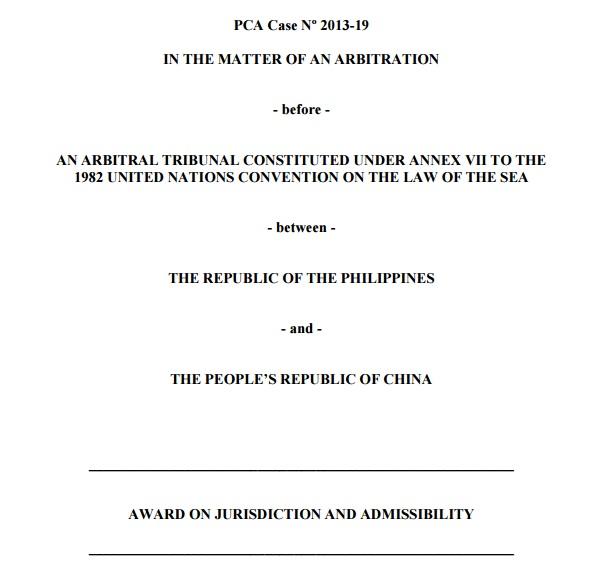Int'l tribunal takes jurisdiction of PHL case versus China

The members of the Permanent Court of Arbitration in case of the Philippines v. China. They are (from left) Judge Jean-Pierre Cot, Judge Stanislaw Pawlak, Judge Thomas A. Mensah (President), Judge Rüdiger Wolfrum, Professor Alfred H. A. Soons (http://www.pca-cpa.org/)
(Updated 10:18 a.m.) The Permanent Court of Arbitration in The Hague on Thursday ruled that it has immediate jurisdiction over seven out of 15 issues raised against China by the Philippines, which is asking the tribunal to declare Beijing’s sweeping claims over the disputed areas in the South China Sea illegal and excessive.
In an initial legal setback for China and a victory for the Philippines, which filed the case in January 2013, the tribunal has set hearings and said that it expects to hand down a ruling on the case next year.
The tribunal also rejected China’s contention that The Hague-based tribunal did not have authority to rule on the case.
Filipino government officials and diplomats said the Philippines ran into a "dead end" when it tried to resolve territorial disputes with China through nearly two decades of bilateral talks, prompting the country to eventually decide to bring the long-simmering conflicts to international arbitration.
In its ruling on Oct. 29, the Permanent Court of Arbitration in The Hague said its jurisdiction with respect to seven other issues, or “submissions” in arbitration parlance, by the Philippines remain pending and “will need to be considered in conjunction with the merits.”
These include a move by the Philippine government to invalidate China’s nine-dash line, the country's basis to claim almost all of the South China Sea.
Another Philippine submission, on the other hand, needs to be clarified and narrowed by the court.

In its decision, the tribunal rejected China’s position that the court cannot assume jurisdiction over the case because it deals with sovereignty over the features in the resource-rich waters, which China says is beyond the tribunal's scope under the 1982 UN Convention on the Law of the Sea or UNCLOS.
China, which insists on its “indisputable” and “historical” claim over virtually the entire waters in the South China Sea, did not participate in the proceedings, saying it does not recognize the Philippines’ case.
After assuming jurisdiction on the Philippine case, a hearing on the merits of the Philippines’ claims will be convened by the tribunal soon.
“In consultation with the parties, the tribunal has provisionally set the dates for the merits hearing,” a statement issued by the tribunal said, adding that it will not be open to the public.
However, it said the tribunal will consider requests from interested states to send small delegations of observers.
The tribunal expects to render its award on the merits and remaining jurisdictional issues in 2016.
PHL welcomes decision
Immediate jurisdiction
Among the seven issues where the court has declared immediate jurisdiction are:
- Scarborough Shoal generates no entitlement to an exclusive economic zone or continental shelf;
- Mischief Reef, Second Thomas Shoal and Subi Reef are low-tide elevations that do not generate entitlement to a territorial sea, exclusive economic zone or continental shelf, and are not features that are capable of appropriation by occupation or otherwise;
- Gaven Reef and McKennan Reef (including Hughes Reef) are low-tide elevations that do not generate entitlement to a territorial sea, exclusive economic zone or continental shelf, but their low-water line may be used to determine the baseline from which the breadth of the territorial sea of Namyit and Sin Cowe, respectively, is measured;
- Johnson Reef, Cuarteron Reef and Fiery Cross Reef generate no entitlement to an exclusive economic zone or continental shelf;
- China has unlawfully prevented Philippine fishermen from pursuing their livelihoods by interfering with traditional fishing activities at Scarborough Shoal
- China has violated its obligations under the Convention to protect and preserve the marine environment at Scarborough Shoal and Second Thomas Shoal; and
- China has breached its obligations under the Convention by operating its law enforcement vessels in a dangerous manner causing serious risk of collision to Philippine vessels navigating in the vicinity of Scarborough Shoal.
Seven issues still to be considered
Seven other issues being considered by the tribunal for jurisdiction while discussing the merits of the case during the hearing are:
- China’s maritime entitlements in the South China Sea, like those of the Philippines, may not extend beyond those permitted by the UNCLOS;
- China’s claims to sovereign rights and jurisdiction, and to “historic rights”, with respect to the maritime areas of the South China Sea encompassed by the so-called “nine-dash line” are contrary to the Convention and without lawful effect to the extent that they exceed the geographic and substantive limits of China’s maritime entitlements under UNCLOS;
- Mischief Reef and Second Thomas Shoal are part of the exclusive economic zone and continental shelf of the Philippines;
- China has unlawfully interfered with the enjoyment and exercise of the sovereign rights of the Philippines with respect to the living and non-living resources of its exclusive economic zone and continental shelf;
- China has unlawfully failed to prevent its nationals and vessels from exploiting the living resources in the exclusive economic zone of the Philippines;
- China’s occupation and construction activities on Mischief Reef (a) violate the provisions of the Convention concerning artificial islands, installations and structures; (b) violate China’s duties to protect and preserve the marine environment under the Convention; and (c) constitute unlawful acts of attempted appropriation in violation of the Convention; and
- Since the commencement of this arbitration in January 2013, China has unlawfully aggravated and extended the dispute by, among other things: (a) interfering with the Philippines’ rights of navigation in the waters at, and adjacent to, Second Thomas Shoal; (b) preventing the rotation and resupply of Philippine personnel stationed at Second Thomas Shoal; and (c) endangering the health and well-being of Philippine personnel stationed at Second Thomas Shoal.
The court, meanwhile, directed the Philippines to clarify one submission, the one on China desisting "from further unlawful claims and activities.”
Bound by the UNCLOS
According to the court, its president ruling “does not decide any aspect of the merits of the parties’ dispute,” but noted that both countries, which are signatories to the UNCLOS, “are bound by its provisions on the settlement of disputes.”
The tribunal has also held that “China’s decision not to participate in these proceedings does not deprive the tribunal of jurisdiction and that the Philippines’ decision to commence arbitration unilaterally was not an abuse of the Convention’s dispute settlement procedures.”
It likewise rejected the argument set out in China’s December 2014 position paper that their dispute with the Philippines “is actually about the delimitation of a maritime boundary between them and therefore excluded from the tribunal’s jurisdiction.”
The tribunal declared that “each of one of the Philippines’ submissions reflect disputes between the two States concerning the interpretation or application of the convention.”
The Philippines has repeatedly said that its case does not require or even invite the tribunal “to make any determinations on questions of land sovereignty, or delimitation of maritime boundaries.”
China has repeatedly stated that “it will neither accept nor participate in the arbitration unilaterally initiated by the Philippines,” saying the case is baseless and lacks legal merit.
Beijing maintained that the Philippines is bound by the 2002 Declaration on the Conduct of Parties in the South China Sea – a non-binding non-aggression pact signed between China and the Association of Southeast Asian Nations – that the sea dispute will be only be resolved through direct negotiations.
The Philippines, along with other claimants Vietnam, Malaysia and Brunei are members of the ASEAN, which also includes Indonesia, Singapore, Thailand, Cambodia, Laos and Myanmar.
The tribunal debunked China’s argument contained in its position paper, which submitted to the court even if the country has declared that it was not participating in the legal proceedings.
“On the contrary, the tribunal has held that the China– ASEAN Declaration was a political agreement that was not intended to be legally binding and was therefore not relevant to the provisions in the Convention that give priority to the resolution of disputes through any means agreed between the Parties,” it said.
The tribunal also said that “certain other agreements and joint statements by China and the Philippines do not preclude the Philippines from seeking to resolve its dispute with China through the UNCLOS.”
“Further, the tribunal has held that the Philippines has met the Convention’s requirement that the Parties exchange views regarding the settlement of their dispute and has sought to negotiate with China to the extent required by the Convention and general international law,” the statement said.
China frowns on any effort to bring the disputes to any multilateral forum, such as arbitration, insisting on direct talks with smaller rival claimants to the South China Sea.
The South China Sea--a strategic and resource-rich waterway where more than 50 percent of the world's merchant fleet tonnage passes each year--has been a source of conflict among rival claimants.
Overlapping claims in the contested waters, islands and reefs, where undersea gas deposits
Tensions flared anew after China beefed up its reclamation activities in disputed areas and transformed seven previously submerged features into artificial islands with buildings several stories high with at least two runways despite concerns raised by several countries, including the US.
Although it is not a party to the conflict, the US has declared several times that peace and freedom of navigation operations in the waters, where a bulk of the world’s trade pass, is in its national interest.
Challenging China’s claim, the US conducted freedom of navigation operation in the waters near China’s man-made islands on Tuesday, sending the USS Lassen, a guided US missile destroyer, to sail within 12 nautical miles of at least one of the features claimed by Beijing.
The move infuriated Beijing, which called Washington’s action a threat to its sovereignty. -NB/ELR/RSJ, GMA News



